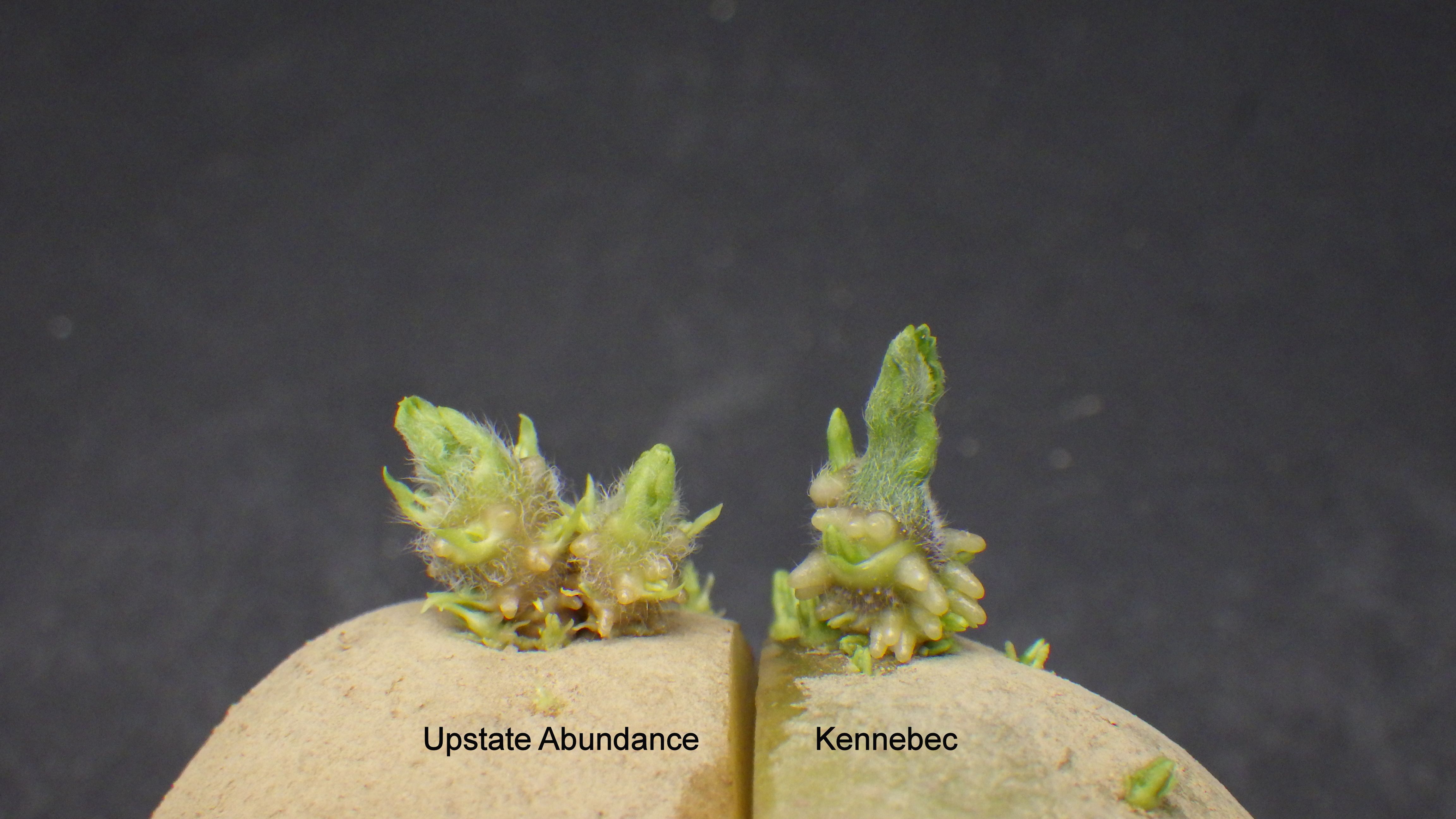Upstate Abundance
| Denomination: | 'Upstate Abundance' |
|---|---|
| Previously Proposed Denomination: | 'Baby Blanca' |
| Synonym: | NY150 |
| Botanical Name: | Solanum tuberosum |
| Applicant/Holder: |
Cornell University Center for Technology Licensing 395 Pine Tree Road, Suite 310 Ithaca, New York 14850 United States of America |
| Breeder: |
Walter De Jong, Cornell University, Ithaca, United States of America |
| Agent in Canada: |
La Patate Lac-St-Jean 52, Edouard-Niquet Péribonka, Quebec G0W 2G0 Canada Tel: 418-374-2292 |
| Application Date: | 2017-12-18 |
| Provisional Protection:: | 2017-12-18 |
| Application Number: | 17-9349 |
| Grant of Rights Date: | 2020-07-20 |
| Certificate Number: | 6234 |
| Grant of Rights Termination Date: | 2040-07-20 |
Variety Description
Variety used for comparison: 'Kennebec'
Summary: The lightsprout of 'Upstate Abundance' has dense pubescence at the base whereas the lightsprout of 'Kennebec' has a medium density of pubescence at the base. The tip of the lightsprout of 'Upstate Abundance' has an intermediate habit whereas that of 'Kennebec' has a closed habit. The lightsprout of 'Upstate Abundance' has a medium number root tips whereas 'Kennebec' has many root tips. The leaf outline of 'Upstate Abundance' is small to medium sized whereas the leaf outline of 'Kennebec' is large. The second pair of lateral leaflets are small to medium sized in 'Upstate Abundance' whereas they are medium to large in 'Kennebec'. The terminal and lateral leaflets for 'Upstate Abundance' have a medium frequency of coalescence whereas the frequency is absent or very low for 'Kennebec'. The tuber of 'Upstate Abundance' is round with shallow eyes whereas the tuber of 'Kennebec' has an oval to long oval shape with eyes at a medium depth.
Description:
LIGHTSPROUT: medium size, ovoid, medium number of root tips, short lateral shoots
LIGHTSPROUT BASE: weak to medium intensity of anthocyanin colouration, medium proportion of blue in anthocyanin colouration, dense pubescence
LIGHTSPROUT TIP: small in relation to base, intermediate openness, absent or very weak intensity of anthocyanin colouration, medium density of pubescence
PLANT: intermediate to leaf type foliage structure where foliage is half open to closed with stems partly to hardly visible, semi-upright growth habit, matures mid-season
STEM: absent or very low extent of anthocyanin colouration
LEAF: small to medium size outline, open, weak to medium presence of secondary leaflets, light to medium green upper side, absent or very low extent and absent or very weak intensity of anthocyanin colouration of upper side of midrib, medium frequency of coalescence of terminal and lateral leaflets
SECOND PAIR OF LATERAL LEAFLETS: small to medium size, leaflet is narrower than long
LEAFLET: absent or very weak to weak waviness of margin, medium depth of veins, dull to medium glossiness on upper side, pubescence on blade at apical rosette
PEDUNCLE: absent or very low extent of anthocyanin colouration
INFLORESCENCE: low frequency per plant, small
FLOWER BUD: absent or very low extent of anthocyanin colouration
COROLLA: medium size
COROLLA (INNER SIDE): absent or very low extent of anthocyanin colouration, absent or very weak intensity of anthocyanin colouration, absent or low proportion of blue in anthocyanin colouration
TUBER: round, white flesh
TUBER EYE: shallow depth, yellow at base
TUBER SKIN: yellow, develops weak intensity of anthocyanin colouration in reaction to light
Origin & Breeding History: 'Upstate Abundance' (experimental designation NY150) originated from the cross between NY121, as the female parent, and 'Jacqueline Lee', as the male parent, conducted at the Cornell University breeding station in Ithaca, New York, USA, in 2000. The resulting seed was sown in a greenhouse in 2005 and the resulting tubers field planted in Ithaca New York, in 2006. One of the progeny, designated as NY150, was identified in 2006. Selection criteria was based on negative mass selection for agronomic characteristics and disease resistance.
Tests & Trials: The comparative trial for 'Upstate Abundance' was conducted by Global Agri Services Inc. during the 2018 growing season in Drummond, New Brunswick. The trial consisted of a single, 21 metre long row containing 70 plants spaced 0.3 metres apart for each variety. The distance between rows within the trial was 0.9 metres. Observations and measurements were taken from 10 plants, or 10 parts of plants, of each variety.
Click on image for larger view

Potato: 'Upstate Abundance' (left) with reference variety 'Kennebec' (right)
- Date modified: